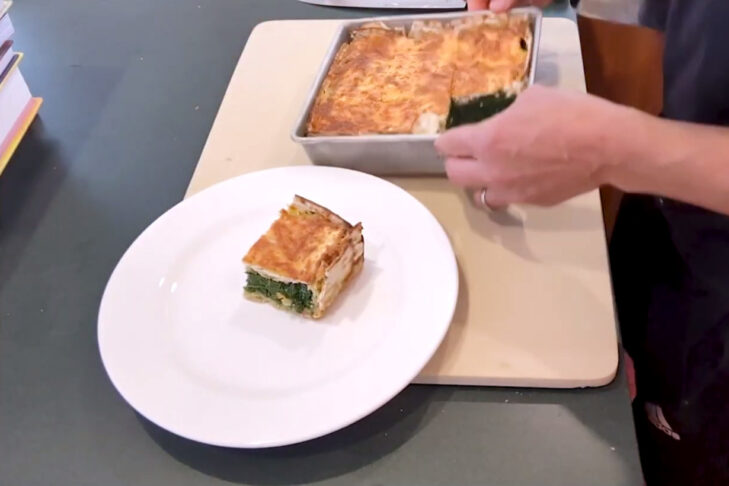Early in the Passover seder, participants point to the matzo and say: “This is the bread of affliction that our ancestors ate in the land of Egypt. Let all who are hungry come and eat. Let all who are needy come and celebrate Passover.” It’s a segue into remembering our ancestors’ suffering during the Exodus and the Jewish value of opening one’s home to feed those less fortunate than we are. The Ladino translation of these words is etched in my mind and soul. At every seder of my childhood, my mother and aunt stood up and proudly sang a beautiful lilting Sephardic melody featuring the words.
Here’s what they sang in Ladino:
Este el pan de lay afrisyon ke comyeron muestros padres en tierra de Ayifto
Tod el ke tiene ambre venga y coma.
Todo el ke tiene de menester venga y paskue.
Este anyo aki, a el anyo el vinien en Tierra de Yisrael.
Este anyo aki siervos, a el anyo el vinien en Tierra de Yisrael ijos foros.
Ladino’s resemblance to Spanish harkens back to the Golden Age of Sephardic Jewry in Spain. It is to Spanish what Shakespearean English is to modern English. Ladino, however, also has Portuguese, Dutch, Hebrew and Arabic words. This unique stew of languages reflects the myriad countries of the Sephardic Jewish diaspora. Similarly, Sephardic cuisine is a rich mix of flavors incorporated from places like Portugal, the Netherlands, the Balkans, the Isle of Rhodes, the Middle East and Moorish Spain.
The humble matzo has also evolved since it was designated as “the bread of affliction” in the Haggadah. Although indelibly associated with the Israelites fleeing Egypt with no time for their loaves of bread to rise, matzo has enjoyed a culinary renaissance in recent decades. It makes for a sweet dessert when covered in caramel or chocolate. Ground into meal, it’s the basis of matzo balls that, depending on tastes and family traditions, are either light and fluffy or dense enough to sink.
Cooks throughout the Sephardic diaspora have used matzo to make layered and savory matzo pies called mina. Chef Michael Leviton recently demonstrated how to make mina in a virtual event hosted by Jewish Arts Collaborative (JArts). The event, part of the Kitchen Explorations series by JArts, originated with Leviton’s interest in telling Jewish stories within the context of food. In partnership with The Wyner Family Jewish Heritage Center and The Vilna Shul, Leviton had access to a rich archive of recipes from Jewish families in Massachusetts.
In a 30-minute cooking demonstration laced with commentary, Leviton took viewers through the steps of making mina. He made a dairy version of the dish that included amplifying the flavor with pecorino cheese. After soaking the matzo and cooking the spinach, he made an egg-and-cheese mixture, creating something akin to a Sephardic-Ottoman-kosher-for-Passover lasagna.
There are mina fillings that include lamb and beef generously spiced with fresh herbs. There are also vegan and vegetarian mina recipes that use eggplant and other vegetables. Newton resident Becky Behar Mekler’s father and maternal grandparents were born in Istanbul. Behar Mekler grew up in Bogotá, Colombia, until she was 6, and then lived in Miami until college. In the tradition of many creative home cooks, she eyeballs the ingredients for her mina (see the recipe below), which includes a top layer of whipped potatoes, egg whites and cheese. She said she still makes mina for Passover and serves it with honey, a tradition in her family.
Fran Putnoi’s ancestors fled Spain during the Inquisition and eventually emigrated to Izmir, Turkey, by way of Italy. Putnoi was recently profiled in The Boston Globe’s food pages, which featured her recipe for mina de carne. As the name implies, her mina has a meat filling. Putnoi, who lives in Cambridge, remembers her Sephardic grandparents conducting long seders in Ladino in their Upper West Side apartment.
Whatever the mina filling, the matzo “pie” is always layered in between at least three matzo sheets that have been softened with water. Some recipes call for glazing the top layer with an egg wash. Cooking times vary according to the other ingredients, but in the end, the result is the same. Matzo that is the main ingredient in recipes like mina is much more appealing than “the bread of affliction that our ancestors ate in the land of Egypt” (“el pan de lay afrisyon ke comyeron muestros padres en tierra de Ayifto“).
Mina de Espinaca (Spinach, Cheese and Matzo Pie) by Becky Behar Mekler
Makes 6-8 servings (total time about 90 minutes)
Ingredients
- 5 potatoes, gold or russet, peeled
- 2 tablespoons salt, divided
- 1 cup shredded Parmesan cheese, divided
- 2 1-pound bags assorted grated cheeses (sharp cheddar, mozzarella or Mexican blend without taco seasoning)
- 6 eggs (4 separated into whites and yolks)
- 2 bags fresh spinach or 4 packages frozen spinach, defrosted and finely chopped (if using frozen spinach, make sure you squeeze out the water before using)
- 4-5 plain matzo sheets
- Vegetable oil, divided
Directions
- Boil potatoes until you can pierce a fork through them.
- Make spinach mixture by combining spinach, ½ cup Parmesan cheese, grated cheeses, 2 eggs, lightly beaten, one mashed potato and salt, to taste. Set aside.
- Put three pieces of matzo in a dish filled with warm water and some salt. Allow to get wet but not too soggy. Take out of the water after a minute or so and dry both sides with paper towels.
- Warm a deep stainless-steel pan with vegetable oil on the stovetop and carefully line the bottom and sides with the pre-wet matzo (it’s OK if it breaks; use the broken pieces to fill any gaps in the pan). A springform pan may also be used, but I have always used the same oven-friendly pan with handles.
- Put spinach mixture on top. Add another sheet of wet matzo on top of spinach mixture.
- Make the potato mixture, which consists of four egg whites beaten until peaks form, four egg yolks, four mashed potatoes, remaining ½ cup Parmesan cheese and some salt. Fold all ingredients together and put as top layer of spinach pie.
- Drizzle vegetable oil on top and place the pan in a preheated 350-degree oven for 45-60 minutes, or until mina is golden-brown.
- Allow mina to cool for about 5 minutes and then run the tip of a sharp knife along the outside edges to separate it from the pan. Once cooler, invert the mina onto a large plate and then reinvert onto your serving dish. (If you use a springform pan, there’s no need to invert and reinvert!)
- Serve hot with some honey on the side.



